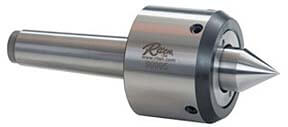- 800-338-0027
- Contact Us
PRODUCT SEARCH:
Enter a keyword or part number in the box below:
Special Carbide Tip Dead Centers
Dead Center Applications
Riten “Fast-Trak” special carbide dead centers are suitable for all machining and grinding applications.

Dead Center Availability
“Fast-Trak” carbide dead centers are readily available from stock in Morse and Jarno Tapers. These dead centers feature longer lengths, larger carbides and increased wheel clearance for grinding applications. Point styles are limited to full and half dead centers in carbide tip configurations. Style 3 dead centers are carbide tipped full centers and Style 4 dead centers are carbide tipped half centers. When ordering specify the base model number and the style number to create the full five digit part number. For example a 7905, Style 3 dead center is a 3 Morse Taper, carbide tipped, full dead center whose complete part number is 79053.
These centers were designed to fit the need for a readily available off the shelf carbide tipped dead center with larger carbide and/or extra length. As the largest manufacturer of standard and custom dead centers in North America, Riten Industries recognized the need for a standardized series of carbide tipped dead centers that provided additional clearance. Until that time, these dead centers were strictly custom tools with lead times of six weeks or more.
Custom variations of any Riten dead centers can be designed using our on-line design tool or by discussing your application with one of our product specialists.
Dead Center Technical Specifications – Carbide-Tipped Dead Centers
The steel shank is manufactured from 52100 ball bearing steel. Since the carbide tip is the wear surface in carbide tipped dead centers, only the knock out end of the steel body is hardened. The carbide tip provides the hardness and wear resistance required for high production turning and grinding applications. Concentricity is guaranteed to .0002 inches TIR
Dead Center Regrind
Both steel and carbide tipped dead centers can be reground to extend the life of the dead center. One of the many advantages of 52100 over case hardened materials is that the point can be reground without affecting the hardness or durability of the center. Dead centers should be returned to the factory for inspection to determine the cost of regrinding the tool. The point angle will be reground to factory specifications and the concentricity of the point to the taper will be restored. If necessary, the mounting taper will be reground as well during the reconditioning process.

 * Part numbers for
* Part numbers for 